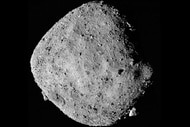Create a free profile to get unlimited access to exclusive videos, sweepstakes, and more!
Game of Asteroids: NASA and FEMA gear up for simulation of responding to a direct hit

Doomsday sci-fi movie producers take note: You’ll probably wish you had a seat at the table this coming week, when two government agencies put on their thinking caps for a mock drill on how to answer a natural threat of galactic proportions.
NASA and FEMA announced this week they’ll be partnering with other agencies (including Europe’s ESA) to conduct a “tabletop exercise” at the upcoming Planetary Defense Conference, one designed to work through “a realistic — but fictional — scenario for an asteroid on an impact trajectory with Earth,” according to NASA.
Keeping in mind that none of this is real, here’s how the agency describes the scenario they’ve come up with to test the government’s response plan for a direct hit from a near-earth object (NEO):
“The scenario begins with the fictional premise that on March 26, astronomers ‘discovered’ a NEO they consider potentially hazardous to Earth. After a ‘few months’ of tracking, observers predict that this NEO — dubbed 2019 PDC — poses a 1 in 100 chance of impact with Earth in 2027 (in real life, the international community has decided that a 1 in 100 chance of impact is the threshold for action). Participants in this exercise will discuss potential preparations for asteroid reconnaissance and deflection missions and planning for mitigation of a potential impact's effects.”
For a much, much more detailed description — headlined by a big, red message assuring readers that all of this is, again, completely fictional — check out “Day zero” of NASA’s five-day scenario training page.
Working with disaster recovery experts like FEMA, says NASA, helps bridge communication between science and the on-the-ground places where that science is applied. In past joint training exercises (there’ve been five so far), “[w]hat NASA has learned from working with FEMA is that emergency management officials are not focused on the scientific details about the asteroid” and are instead focused on “when, where and how an asteroid would impact, and the type and extent of damage that could occur," according to FEMA’s Leviticus Lewis.
As the scenario unfolds next week, we’re hoping for more updates from the agencies that’ll give us an idea of what a near-miss (or post-impact) action plan might look like. Until then, we’ll just go on happily assuming that Armageddon got everything right.














